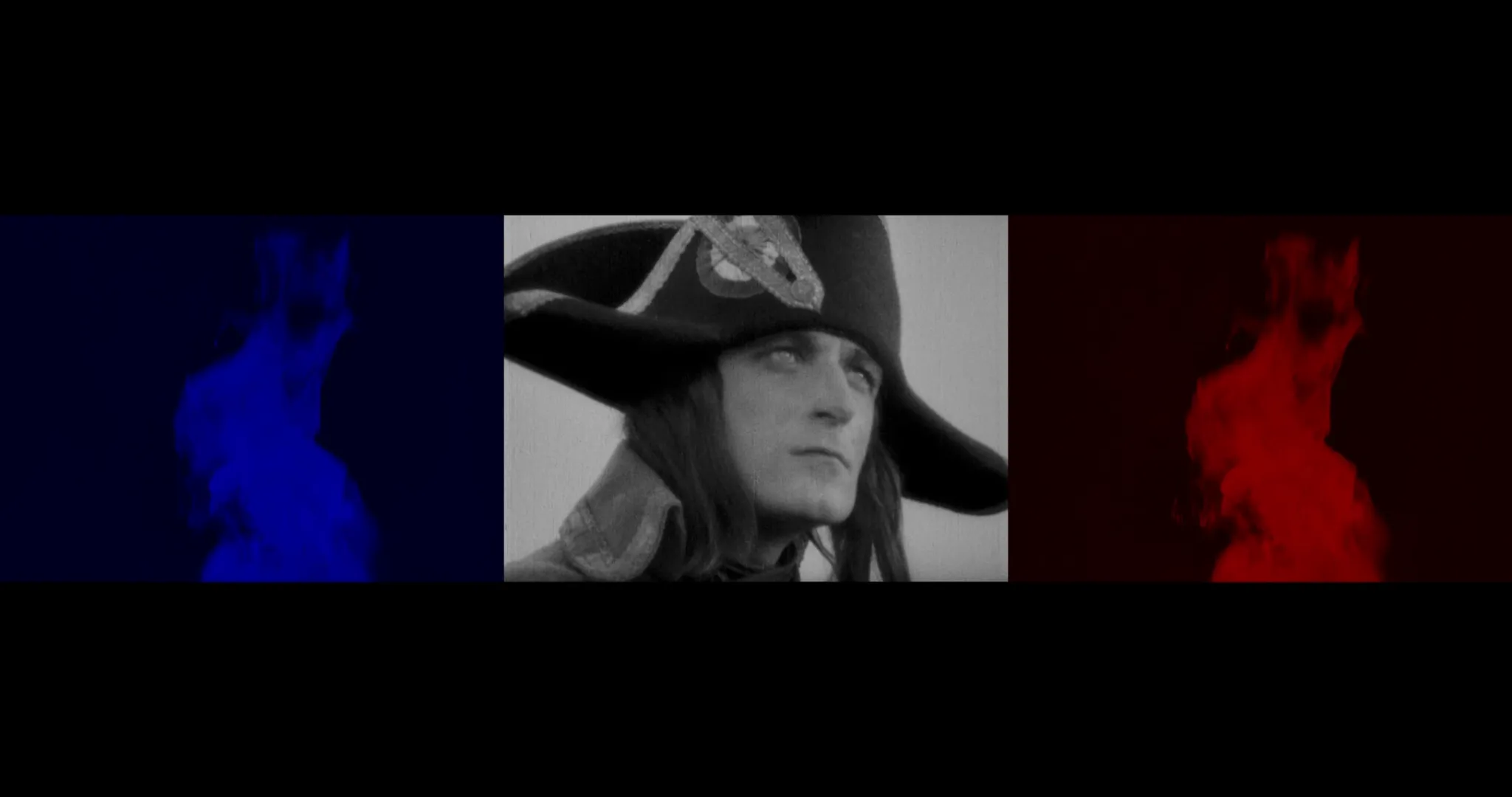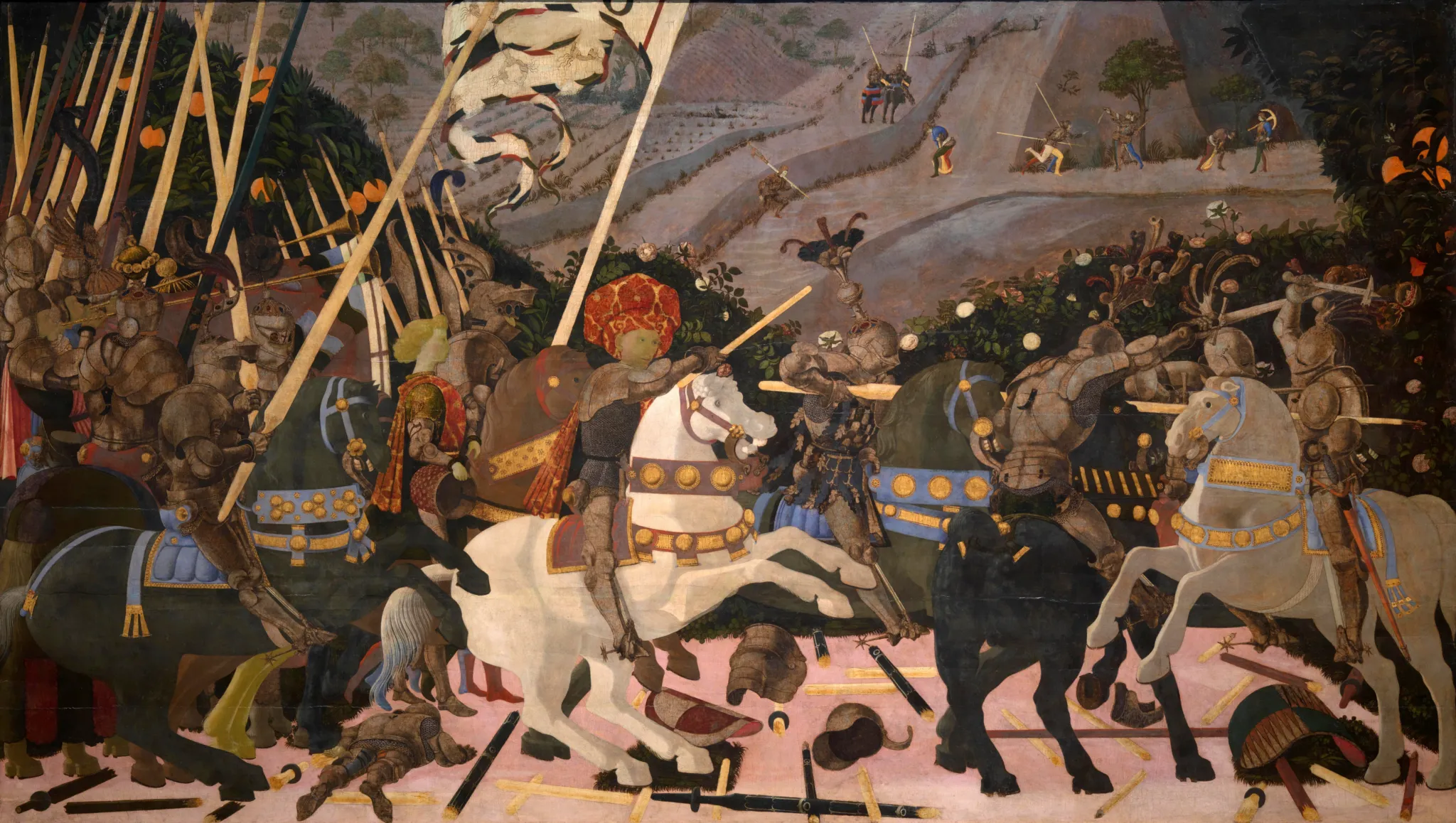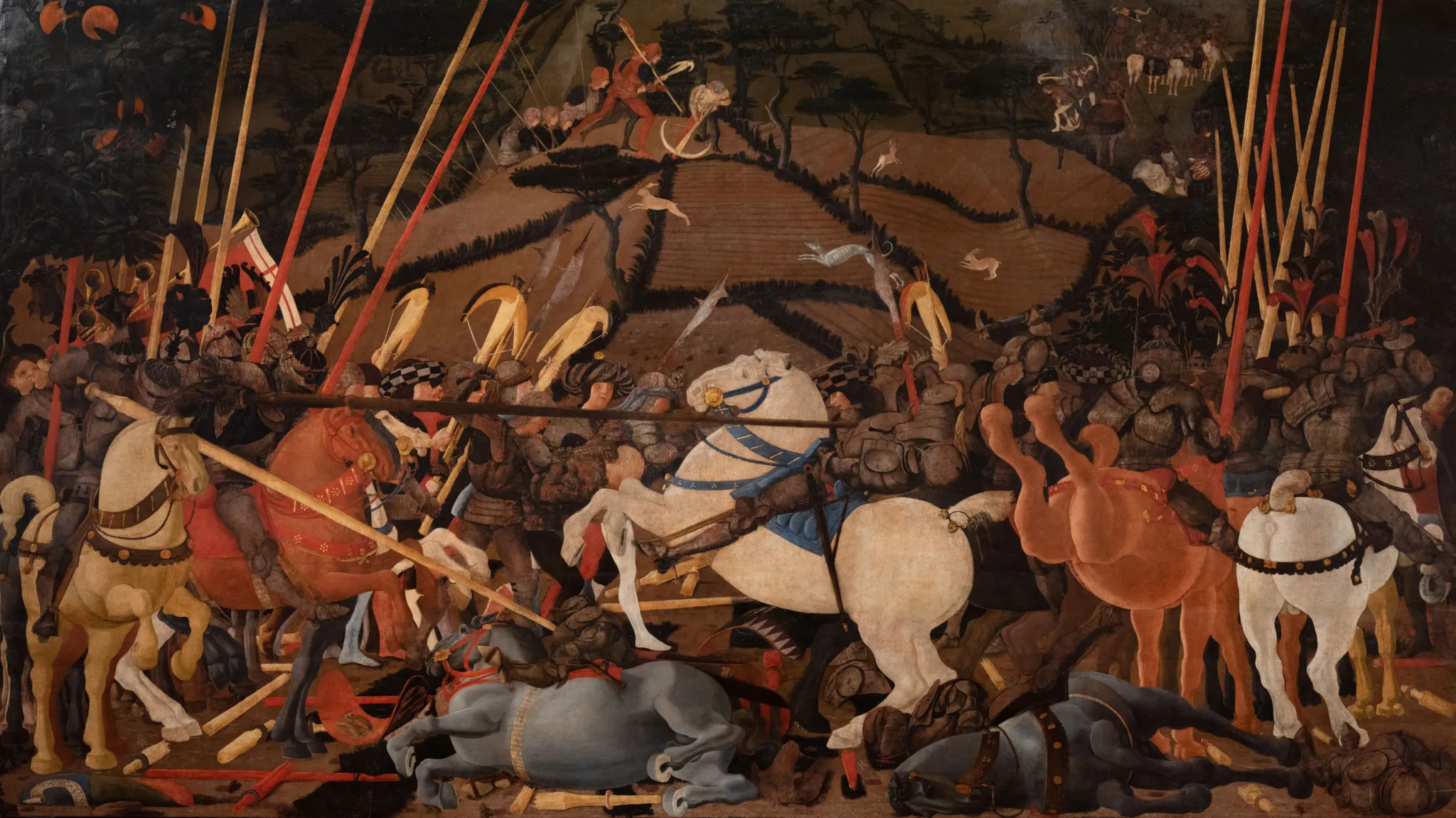Please update your browser
Your current browser version is outdated. We recommend updating to the latest version for an improved and secure browsing experience.

Abel Gance's Polyvision
Abel Gance conceived of his Napoléon project as a “giant moving fresco” that would create a new relationship between viewer and image. The original plan entailed the production of a series of six, three-hour films - Arcole, 18 Brumaire, Austerlitz, Retreat from Moscow, Waterloo, and Saint Hélène - to begin in 1782 with Napoleon as a cadet at the Royal Military Academy of Brienne and end with his 1821 death. In 1924, Gance expanded his plans even further, envisioning a series of eight linked films of 2,400 meters each. Had this been realized, Napoléon’s projection time would have been nearly twelve hours.
Since the creation of the first film took three years and went heavily over budget, none of the subsequent episodes were made. The finished film, Napoléon vu par Abel Gance, ended with the beginning of Napoleon’s Italian campaign and included two “triptych” sequences in which three images were projected side-by-side on an enormous screen. As with the panoramas that inspired them, the presence of the triptych sequences necessitated special exhibition conditions, and the film was premiered at the Opéra de Paris on April 7, 1927, with an original Arthur Honegger score. Distributed in France and internationally in versions of various lengths, Napoléon was later re-released in alternate, sound versions edited by Gance himself.
Although many contemporary critics regarded them as Gance’s most important innovation, none of these shortened versions included the triptychs (below), which were re-integrated only in 1979 with Kevin Brownlow’s first restoration.

The Era of the Image Has Arrived
In making Napoléon, Gance strove to create a massive film synthesizing all the arts and acting as the “Gospel of the future, a bridge of dreams leading from one era to another.” Earlier films like J’accuse (1919) and especially La Roue (1923) had already established Gance as a central figure in French debates over cinema’s status as an art. Gance’s writings frequently compared his films to symphonies and frescoes, and, like Napoléon, many earlier Gance works cited canonical masterworks, such as the Beethoven pieces visually “performed” in La Dixième Symphonie (1918) and the reproduction of Sandro Botticelli’s Birth of Venus (1485) used as the backdrop for the allegorical “Dance of Death” sequence in J’accuse. For many of the era’s most important theorists and critics, these were retrograde elements in the work of a prodigious innovator whose main achievement was his control of rhythm and the concomitant liberation of cinematic plasticity from the constraints of narrative.
In La Roue, for example, Gance alternates shots of a train with increasingly brief shots of pieces of the rail and the surrounding landscape, gradually reducing the number of frames per shot until he is finally intercutting barely perceptible images. These montage bursts had an enormous impact on Gance’s contemporaries and elicited rhapsodic praise from many of the artists and filmmakers interested in raising cinema’s cultural status. Fernand Léger (who designed the film’s poster) spoke for many of his colleagues in writing, “With La Roue, Abel Gance has elevated the art of film to the plane of the plastic arts.”
Napoléon employed virtually every technique at Gance’s disposal, and invented several others, including a 360-degree camera mechanism that could be operated from a distance. All of these were intended to increase the viewer’s affective participation, to, as Gance put it, “make the spectator become an actor... to involve him at every level in the unfolding of the action... to sweep him away on the flow of pictures.”
Gance’s objective was to enhance collective involvement in the diegetic process, and he frequently used combinations of camera movement and rapid cutting to achieve this effect, thematically connecting them to emblematic events. The triptych sequences in Napoléon fuse Gance’s interest in maximizing the sensory impact of his imagery with his desire to engender a greater degree of spectatorial engagement. Gance had been experimenting with masking and screen proportions since at least 1917; his original idea was to increase the breadth of the image by deploying additional screens to the right and left of the center, creating a "panoramic screen.” Since Gance initially had no way to see what the three images would look like projected together, he concentrated on creating "panoramic triptychs" of Napoleon’s proclamations to the army in Italy and of the Battle of Montenotte. Gance was able to supplement these panoramic shots with additional triptychs created by combining images shot with a single camera, sometimes amplifying the effect with superimposition.
The concluding triptych begins with Napoleon riding his white horse back and forth among the troops, his movement linking massed units of soldiers as well as the three triptych panels. These immense, detailed crowd shots, which often foreground lateral motion as a way of emphasizing their breadth, are overtly panoramic, but they are counter-balanced by triptychs operating on a more symbolic level, such as a set of marching soldier images tinted to look like a Tricolor flag. For the Opéra de Paris, the three images were projected together on a screen 15.3 meters wide by 3.85 meters high, with apparently spectacular results: "When the curtains are drawn back, opening out in the wall of the theater that immense breach of light, the effect produced is one of an astonishing power,” critic Emile Vuillermoz wrote: “Gance’s triple screen... has allowed him to reach effortlessly the highest peaks of the lyricism of the image.” Art historian Élie Faure went so far to argue the use of three images opened the cinema up to “extremely fertile territories,” mounting an implicit defense of the “plastic form of film against the continuous encroachments of naturalism.”
Gance differs from panorama painters in interlinking multiple perspectives on the same battle, which suggests an affinity with contemporary practices like Orphic simultaneity and points towards a much older antecedent, Uccello’s three panel treatment of the Battle of San Romano (1438–40, below). Uccello’s three paintings are now divided between London’s National Gallery, the Louvre (Paris), and the Uffizi (Florence), but they were commissioned and intended for display as a group, with the figures’ perspectival arrangements creating both geometric and metaphoric resonances between the individual scenes.
Similarly, Gance used the triple screen to create polyphonic arrangements of distinct but related images, the triptychs serving a musical as well as a structural function. As critic Jean Arroy put it, “One imagines the composer manipulating a giant keyboard under the screen.” This approach’s symphonic aspects are abundantly evident in the film’s final few moments, in which many motifs used earlier are interlaced across the three screens, grounded by arch-Romantic images of Napoleon looking out over the foggy landscape from a mountain peak, like the figure in Caspar David Friedrich’s Wanderer Above a Sea of Fog (1818). The orchestration of these visual elements builds in intensity until, finally, both the protagonist and the film achieve a joint apotheosis signaled by the cuts from a symbolic eagle flying across all three screens to a series of tinted images connecting Napoleon’s face to Promethean flames, mathematical formulas, and the waves of history.
The premiere version of Napoléon included an even more radically contrapuntal triple-screen sequence, the “Double Tempest” montage derived from Hugo’s Ninety-Three (1874), unfortunately now lost. Gance used Hugo’s text as the basis for an extended montage that deepens the implied relationship between the assembly’s disintegration and Napoleon’s absorption of its revolutionary energies. The dynamic fusion of superimposition and rapid editing was pronounced in the original triptych, in which Gance was able to compose “a veritable apocalyptic fresco, a mobile symphony in which, with eight superimpositions per frame, there were sometimes twenty-four interconnected visions.”
Within this maelstrom of densely layered images, movements were able to resonate with one another across all three screens, and although it would be impossible for viewers to relate all the individual fragments together, the cumulative effect must have been extraordinarily intense. This triptych would also have provided a structural echo of the final sequence (above), making much more apparent the fundamental interdependence of physical scale (the triple screen) and explosive montage within Napoléon vu par Abel Gance.




A New Alphabet for Cinema
Technical difficulties notwithstanding, Gance believed that the triple screen would serve as the “foundation for a new alphabet for the cinema,” as he later put it. In February 1928, Gance arranged for the presentation at Montmartre’s Studio 28 of three new triple-screen films created from parts of Napoléon: Galops (Napoleon’s horseback race through Corsica), Danses (the “Bal des victimes” sequence), and Marines (a montage of production footage and seascapes).
Unfortunately, since no other cinema was willing to install permanent triptych equipment, it was virtually impossible for additional films to be produced for the triple screen. Gance nevertheless planned to shoot his next film, La Fin du monde (1931), an internationalist paean to universal brotherhood, entirely using the new technology, until financial necessity forced him to modify his plans. Undaunted, he also tried to also tried to apply it to his unrealized Passion epic, La Divine Tragédie, in the 1940s.
In 1950s, with the advent of new widescreen technologies, Gance wrote a short essay outlining his ideas about “Polyvision” and suggesting ways both panoramic and “variable” triple-screen images could be incorporated into future widescreen films. Repositioning Polyvision as the precursor to widescreen cinema and arguing that it offered unique possibilities for expanding the horizons of vision and of art in the 1950s, Gance predicted it “will suddenly open wide the eyes of modern man who no longer believes in miracles. You only need to re-read Nietzsche’s Birth of Tragedy (1872) to understand that the way ahead is the one I am indicating.”
Gance never abandoned his belief in the power of the awe-inspiring image, reworking similar themes and sometimes even remaking the same films in the hopes of reaching his audience in more intense ways. In the decades following La Fin du monde’s failure, Napoléon remained Gance’s great obsession, but he also returned to his other silent triumphs, incorporating a new version of the rising of the dead in his 1937 sound remake of J’accuse and later using that reworked sequence in Magirama (1956), a Polyvision anthology film (left and below).
Thanks largely to active self-promotion, Gance’s role in the development of widescreen aesthetics was belatedly acknowledged, but no studio in France or America was interested in converting to Polyvision.
However, Gance maintained that his system could be made to work with a single 35mm projector and even, with an inevitable loss of visual quality, 16mm film, which was rapidly becoming the dominant shooting and exhibition stock for independent and avant-garde filmmakers. Inspired by Napoléon, Kenneth Anger presented a triple-screen, 16mm version of Inauguration of the Pleasure Dome (1954) at the 1958 Brussels World’s Fair, with Gance in attendance (he held a Polyvision demonstration at the same festival).
Fellow avant-gardist Bruce Conner developed a triptych version of Cosmic Ray (1961) in 1965 (below).
In general, however, the “varied screen shapes” Gance (and Sergei Eisenstein) advocated for have been used only in the context of split-screen techniques. Jean-Luc Godard argued, in his Cahiers du cinéma review of Magirama, that although triple-screen presentations could “provoke supplementary effects in the sphere of pure sensation,” he admired directors who “achieve a similar or even superior result by more logical means, breaking the frame but not destroying it.”
Godard characteristically takes this idea to its limit in Histoire(s) du cinéma (1988–98), layering multiple streams of imagery and sound on top of one another within the space of a traditional 4:3 frame and implicitly suggesting that Gance’s polyphonic use of superimposition may be as creatively fecund as his experiments with multi-screen projection.





